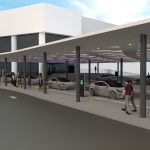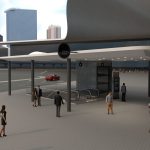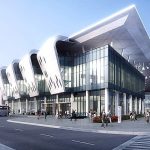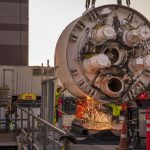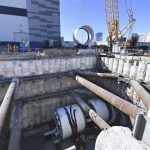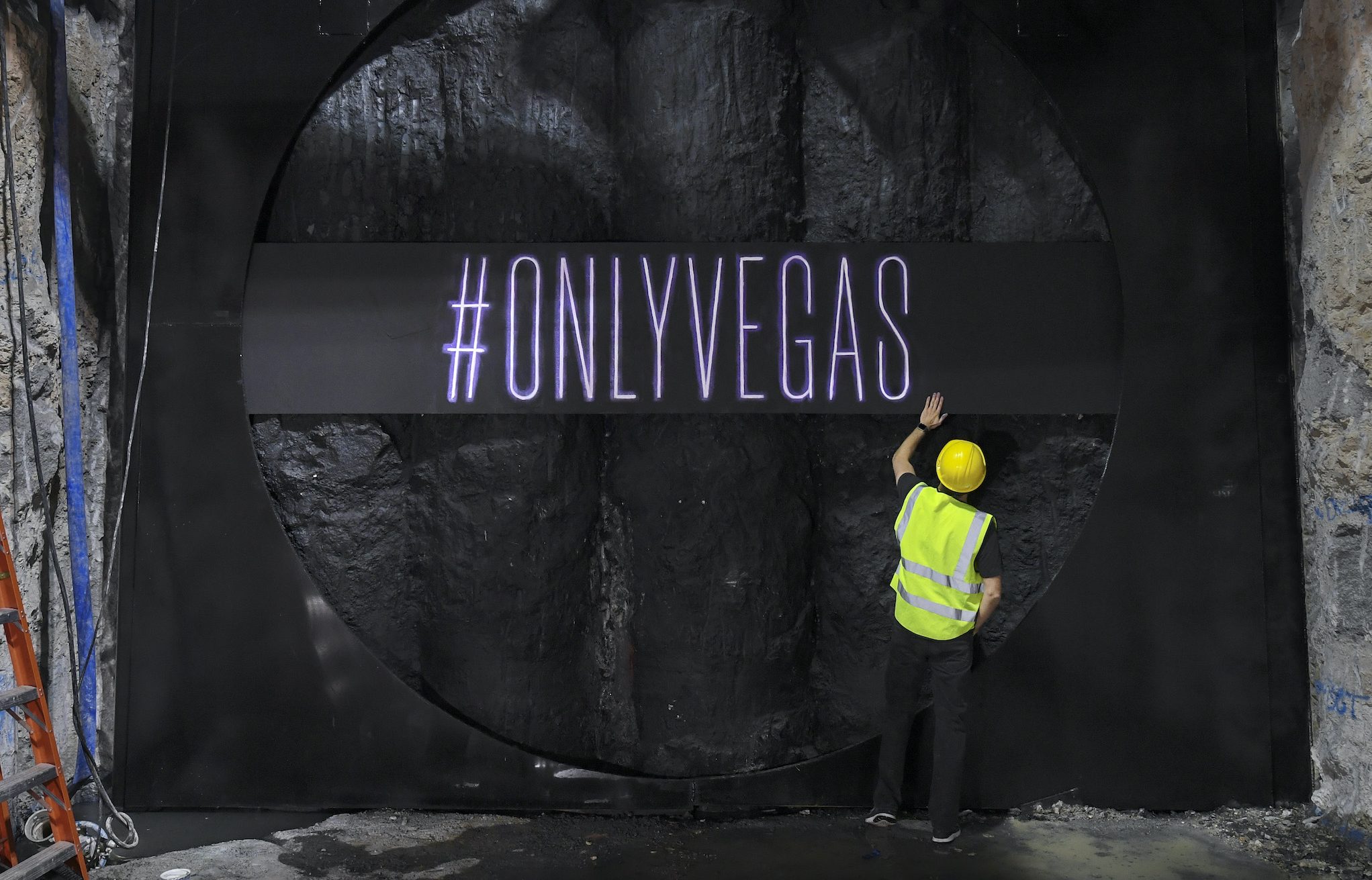

News
Elon Musk’s Boring Company completes Las Vegas tunnel major milestone
The Boring Company’s first Las Vegas tunnel reached a major milestone on Friday after completing excavation on the first of two planned vehicular tunnels beneath the Las Vegas Convention Center campus.
The boring machine broke through its target destination – a concrete wall located on the West Hall convention that’s currently under construction – in record time after tunneling nearly a mile since The Boring Company’s groundbreaking event in Las Vegas on November 15, 2019.
This would mark the first half of its high-speed transport system intended to shuttle convention attendees across the sprawling Las Vegas Convention campus in just over one minute, free of charge, in all-electric Tesla vehicles. Tesla’s goal is to complete the Las Vegas Convention Center’s loop system on time for the next year’s 2021 CES technology show.
Once the first tunnel is completed, the tunneling startup is expected to disassemble its TBM from the west end of the West Hall and moved back to the east end of the East Hall. Doing so completes the second tunnel, and it will mark the completion of the LVCC Loop’s transport line. After this, work will commence on fitting the tunnels to support The Boring Company’s transport pods, which will be ferrying passengers from one end of the LVCC to another.
- Conceptual rendering of a Boring Company People Mover station at the Las Vegas Convention Center, released November 2019. (The Boring Company)
- Conceptual rendering of a Boring Company People Mover station at the Las Vegas Convention Center, released November 2019. (The Boring Company)
The Las Vegas transport tunnels will be the first mainstream project of The Boring Company. Prior to the LVCC Loop, the tunneling startup has only completed a proof-of-concept tunnel in Hawthorne, CA, which involved Tesla Model X SUVs ferrying passengers from one end of the line to another. The Las Vegas tunnel system is poised to utilize another type of vehicle to transport passengers. The line will reportedly be using autonomous vehicles that have enough room for up to 16 people.
While The Boring Company’s transport tunnel in Las Vegas is progressing well, the project is starting to become quite polarizing. In a statement to Inverse, Richard N. Velotta, a journalist who has been following the project’s progress, noted that public opinion has become very mixed today. “What I find most interesting is that those who are opposed are extremely opposed. Those who support are extremely supportive. No middle-of-the-road here,” he said.
Among the LVCC Loop’s critics is Mayor Carolyn Goodman, who argued that the Boring Company and its technology are largely untested, and therefore risky. Yet, it should be noted that the tunneling startup’s contract for the project includes stipulations ensuring that The Boring Company will be liable if the system does not operate as intended. On the other hand, the project also has a number of ardent supporters.
“There are huge supporters, both of the Boring system and Mr. Musk. They point out that Las Vegas, as a gambling city, has always taken big risks to capitalize on big rewards. This project is just such an instance,” said Velotta.
- Workers cut the storage rack from the base of the drill head as the Boring Company prepares to lower the drill head for the People Mover tunnel which will connect convention halls as part of the LVCCD Phase 2 construction in the Red Lot east of the south Hall at the Las Vegas Convention center on Monday, Oct. 28, 2019. (Mark Damon/Las Vegas News Bureau)
- Workers from the Boring Company guide the third of three parts of the drill which will make the tunnel for the People Mover which will connect convention halls as part of the LVCCD Phase 2 construction in the Red Lot east of the south Hall at the Las Vegas Convention center Tuesday, October 29, 2019. (Sam Morris/Las Vegas News Bureau)
- Ryan Rabbass works on painting the LVCVAís new slogan ì#onlyvegasî on the wall of a pit that The Boring Company drill will emerge from Wednesday, February 12, 2020, at the Las Vegas Convention Centerís new West Hall. (Sam Morris/Las Vegas News Bureau)
(Press release from the Las Vegas Convention and Visitors Authority)
Las Vegas Convention Center Celebrates Major Milestone in Elon Musk’s Innovative Underground Transportation System; Excavation of First Tunnel Complete
LAS VEGAS – The Las Vegas Convention and Visitors Authority (LVCVA) today announced that excavation is complete in the first of two vehicular tunnels that will comprise TBC – The Boring Company d/b/a Vegas Loop underground transportation system located beneath the Las Vegas Convention Center campus. After tunneling forty feet underground for nearly a mile over the past three months, the boring machine hours ago broke through the concrete wall located near the 1.4 million square foot West Hall convention center expansion, currently under construction, signaling the official completion of excavation for the first of two one-way tunnels.
The Convention Center Loop was designed to serve as an innovative, fun and quick transportation solution to move thousands of convention attendees throughout the more than 200-acre campus with the potential for expansion in the near future to ease congestion throughout the Las Vegas resort corridor.
Next, the machine will be disassembled, transported via trucks and lowered back into the launch pit near the Convention Center’s South Hall where it will begin boring a parallel path adjacent to the first tunnel. The first commercial endeavor for the new tunneling company is designed to transport up to 4,400 convention attendees per hour and is scheduled to debut to the public in January 2021.
“This marks an important milestone in the future of transportation,” said Steve Hill, LVCVA CEO and president. “Las Vegas is proud to lead the way as the first and only destination to offer an underground transportation solution for moving visitors throughout our convention center.”
The $52.5 million underground transportation system will include three passenger stations connecting the existing 3.2 million square-foot of convention space with the convention center’s new West Hall, part of a $1.52 billion expansion and renovation. The system will allow convention attendees to be whisked across the sprawling campus in just over one minute, free of charge, in all-electric Tesla vehicles.
News
Tesla launches in India with Model Y, showing pricing will be biggest challenge
Tesla finally got its Model Y launched in India, but it will surely come at a price for consumers.

Tesla has officially launched in India following years of delays, as it brought its Model Y to the market for the first time on Tuesday.
However, the launch showed that pricing is going to be its biggest challenge. The all-electric Model Y is priced significantly higher than in other major markets in which Tesla operates.
On Tuesday, Tesla’s Model Y went up for sale for 59,89,000 rupees for the Rear-Wheel Drive configuration, while the Long Range Rear-Wheel Drive was priced at 67,89,000.
This equates to $69,686 for the RWD and $78,994 for the Long Range RWD, a substantial markup compared to what these cars sell for in the United States.
🚨 Here’s the difference in price for the Tesla Model Y in the U.S. compared to India.
🚨 59,89,000 is $69,686
🚨 67,89,000 is $78,994 pic.twitter.com/7EUzyWLcED— TESLARATI (@Teslarati) July 15, 2025
Deliveries are currently scheduled for the third quarter, and it will be interesting to see how many units they can sell in the market at this price point.
The price includes tariffs and additional fees that are applied by the Indian government, which has aimed to work with foreign automakers to come to terms on lower duties that increase vehicle cost.
Tesla Model Y seen testing under wraps in India ahead of launch
There is a chance that these duties will be removed, which would create a more stable and affordable pricing model for Tesla in the future. President Trump and Indian Prime Minister Narendra Modi continue to iron out those details.
Maharashtra Chief Minister Devendra Fadnavis said to reporters outside the company’s new outlet in the region (via Reuters):
“In the future, we wish to see R&D and manufacturing done in India, and I am sure at an appropriate stage, Tesla will think about it.”
It appears to be eerily similar to the same “game of chicken” Tesla played with Indian government officials for the past few years. Tesla has always wanted to enter India, but was unable to do so due to these import duties.
India wanted Tesla to commit to building a Gigafactory in the country, but Tesla wanted to test demand first.
It seems this could be that demand test, and the duties are going to have a significant impact on what demand will actually be.
Elon Musk
Tesla ups Robotaxi fare price to another comical figure with service area expansion
Tesla upped its fare price for a Robotaxi ride from $4.20 to, you guessed it, $6.90.

Tesla has upped its fare price for the Robotaxi platform in Austin for the first time since its launch on June 22. The increase came on the same day that Tesla expanded its Service Area for the Robotaxi ride-hailing service, offering rides to a broader portion of the city.
The price is up from $4.20, a figure that many Tesla fans will find amusing, considering CEO Elon Musk has used that number, as well as ’69,’ as a light-hearted attempt at comedy over the past several years.
Musk confirmed yesterday that Tesla would up the price per ride from that $4.20 point to $6.90. Are we really surprised that is what the company decided on, as the expansion of the Service Area also took effect on Monday?
But the price is now a princely $6.90, as foretold in the prophecy 😂
— Elon Musk (@elonmusk) July 14, 2025
The Service Area expansion was also somewhat of a joke too, especially considering the shape of the new region where the driverless service can travel.
I wrote yesterday about how it might be funny, but in reality, it is more of a message to competitors that Tesla can expand in Austin wherever it wants at any time.
Tesla’s Robotaxi expansion wasn’t a joke, it was a warning to competitors
It was only a matter of time before the Robotaxi platform would subject riders to a higher, flat fee for a ride. This is primarily due to two reasons: the size of the access program is increasing, and, more importantly, the service area is expanding in size.
Tesla has already surpassed Waymo in Austin in terms of its service area, which is roughly five square miles larger. Waymo launched driverless rides to the public back in March, while Tesla’s just became available to a small group in June. Tesla has already expanded it, allowing new members to hail a ride from a driverless Model Y nearly every day.
The Robotaxi app is also becoming more robust as Tesla is adding new features with updates. It has already been updated on two occasions, with the most recent improvements being rolled out yesterday.
Tesla updates Robotaxi app with several big changes, including wider service area
News
Tesla Model Y and Model 3 dominate U.S. EV sales despite headwinds
Tesla’s two mainstream vehicles accounted for more than 40% of all EVs sold in the United States in Q2 2025.

Tesla’s Model Y and Model 3 remained the top-selling electric vehicles in the U.S. during Q2 2025, even as the broader EV market dipped 6.3% year-over-year.
The Model Y logged 86,120 units sold, followed by the Model 3 at 48,803. This means that Tesla’s two mainstream vehicles accounted for 43% of all EVs sold in the United States during the second quarter, as per data from Cox Automotive.
Tesla leads amid tax credit uncertainty and a tough first half
Tesla’s performance in Q2 is notable given a series of hurdles earlier in the year. The company temporarily paused Model Y deliveries in Q1 as it transitioned to the production of the new Model Y, and its retail presence was hit by protests and vandalism tied to political backlash against CEO Elon Musk. The fallout carried into Q2, yet Tesla’s two mass-market vehicles still outsold the next eight EVs combined.
Q2 marked just the third-ever YoY decline in quarterly EV sales, totaling 310,839 units. Electric vehicle sales, however, were still up 4.9% from Q1 and reached a record 607,089 units in the first half of 2025. Analysts also expect a surge in Q3 as buyers rush to qualify for federal EV tax credits before they expire on October 1, Cox Automotive noted in a post.
Legacy rivals gain ground, but Tesla holds its commanding lead
General Motors more than doubled its EV volume in the first half of 2025, selling over 78,000 units and boosting its EV market share to 12.9%. Chevrolet became the second-best-selling EV brand, pushing GM past Ford and Hyundai. Tesla, however, still retained a commanding 44.7% electric vehicle market share despite a 12% drop in in Q2 revenue, following a decline of almost 9% in Q1.
Incentives reached record highs in Q2, averaging 14.8% of transaction prices, roughly $8,500 per vehicle. As government support winds down, the used EV market is also gaining momentum, with over 100,000 used EVs sold in Q2.
Q2 2025 Kelley Blue Book EV Sales Report by Simon Alvarez on Scribd
-

 News3 days ago
News3 days agoTesla debuts hands-free Grok AI with update 2025.26: What you need to know
-

 Elon Musk1 week ago
Elon Musk1 week agoElon Musk confirms Grok 4 launch on July 9 with livestream event
-

 Elon Musk5 days ago
Elon Musk5 days agoxAI launches Grok 4 with new $300/month SuperGrok Heavy subscription
-

 News2 weeks ago
News2 weeks agoTesla Model 3 ranks as the safest new car in Europe for 2025, per Euro NCAP tests
-

 Elon Musk2 weeks ago
Elon Musk2 weeks agoxAI’s Memphis data center receives air permit despite community criticism
-

 News5 days ago
News5 days agoTesla begins Robotaxi certification push in Arizona: report
-

 Elon Musk2 weeks ago
Elon Musk2 weeks agoTesla reveals it is using AI to make factories more sustainable: here’s how
-

 Elon Musk2 weeks ago
Elon Musk2 weeks agoTesla scrambles after Musk sidekick exit, CEO takes over sales

